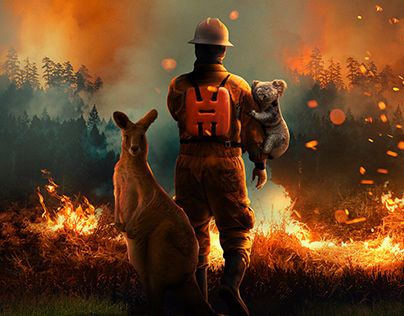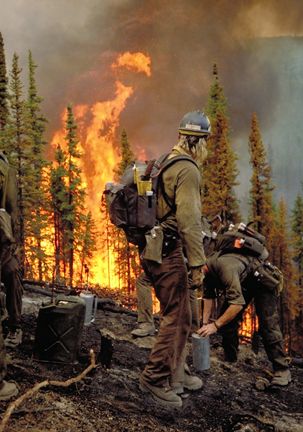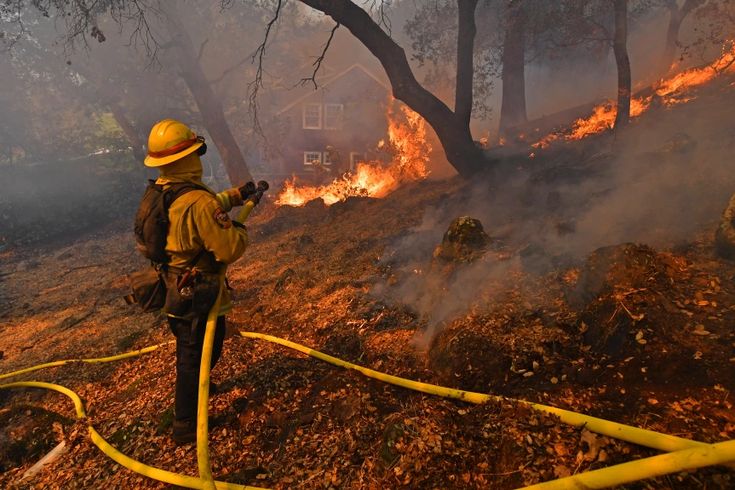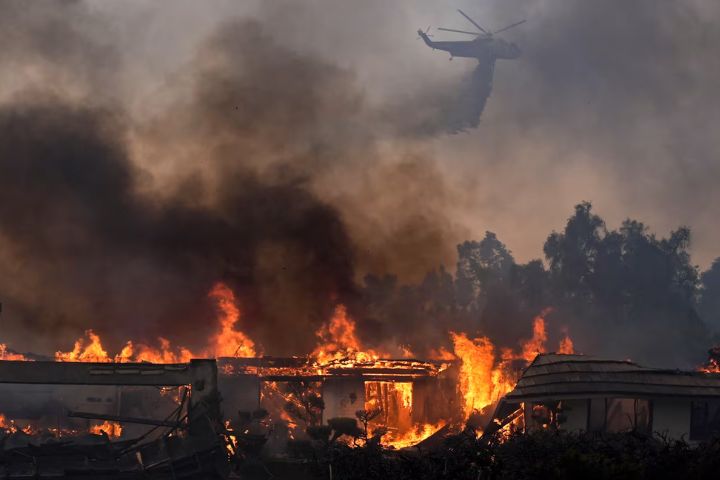A new wildfire has erupted in Ventura County, California, amidst strong winds and dry conditions, presenting a significant challenge for local firefighting crews.

The combination of dangerous weather conditions and the volatile nature of wildfires has escalated the urgency of the situation, with authorities and first responders scrambling to contain the blaze and protect both lives and property. As winds whip through the region, firefighters are racing against time to prevent the fire from spreading further. This report delves into the current crisis, the factors contributing to the fire’s rapid spread, and the challenges firefighters are facing.
The Causes and Growth of the Fire
Ventura County, located along California’s coastline, is no stranger to wildfires. The region is characterized by its Mediterranean climate, with hot, dry summers and mild, wet winters. These conditions can make vegetation particularly susceptible to fires, especially in the late summer and fall when the region is at its driest. When combined with high winds, which can fan the flames, this creates the perfect storm for the rapid spread of wildfires.

The fire in question, which ignited recently in Ventura County, appears to have been fueled by these typical elements. While the exact cause of the fire is still under investigation, experts have pointed to the dry conditions in the area as a likely contributor. The region has been experiencing below-average rainfall in recent months, leaving grasses and shrubs dried out and highly flammable.
On top of this, powerful winds, including gusts exceeding 50 miles per hour in some areas, have significantly complicated firefighting efforts. These winds not only carry embers long distances, but they also shift the fire’s direction unpredictably, making it difficult for crews to establish a solid line of containment. It is not unusual for wildfires in Ventura County to intensify rapidly when these elements come into play, and this fire is no exception.
Impact of Winds on Firefighting Efforts
Firefighters are facing one of their greatest challenges in controlling the fire due to the strong winds. Winds can carry burning embers miles away from the main fire, sparking new flare-ups in different areas, a phenomenon known as “spotting.” This causes the fire to spread far beyond the boundaries initially established by firefighters. The erratic wind patterns also mean that the fire is difficult to predict and contain.
Firefighting crews often rely on firebreaks, which are areas devoid of fuel like trees or brush, to slow the fire’s progress. However, the intensity and variability of the winds make it nearly impossible to build stable firebreaks, as the winds can blow flames across these barriers or cause the fire to jump over them entirely.

Moreover, the strong winds pose a risk to the safety of firefighters on the ground. Visibility can be severely reduced by smoke, and the gusts make it difficult to maneuver equipment. Firefighting aircraft, which are often used to drop water or retardant, may also be grounded during periods of high winds due to safety concerns. This puts additional pressure on ground crews to work faster and more effectively, despite the significant obstacles they face.
The Role of Air Support
While ground crews battle the fire directly, air support plays a crucial role in helping to slow its spread. Helicopters and fixed-wing aircraft, equipped with water tanks and fire retardant, are often deployed to create retardant lines or drop water on the fire. These aerial tactics are especially important in areas where ground access is difficult or where the fire is spreading rapidly.
However, the high winds affecting Ventura County have created challenges for these aerial efforts. Aircraft must be able to safely fly in turbulent conditions, and strong gusts can cause dangerous instability, limiting the amount of time they can spend over the fire. Additionally, high winds can interfere with the effectiveness of water and retardant drops, causing them to disperse in unintended directions or fail to reach critical hot spots.
Despite these obstacles, fire officials are working closely with aviation teams to adjust tactics and maximize the effectiveness of air support. The ability to control the fire from the air can help to prevent its spread to residential areas, buying firefighters on the ground more time to build containment lines.
Evacuations and Safety Concerns
As the fire continues to grow and threaten more areas, officials have issued mandatory evacuation orders for nearby communities. Ventura County, which includes parts of the city of Ventura and other populated areas, has a significant population at risk. The spread of the fire has led to the closure of roads, forcing residents to evacuate quickly and safely. Local authorities are working around the clock to ensure that people are informed and can leave danger zones without delay.

In addition to the danger posed by the fire itself, residents also face health risks from smoke and air quality issues. The intense smoke from the fire has begun to affect air quality in surrounding areas, including parts of Los Angeles and other nearby counties. The particulate matter in the smoke can cause respiratory problems, especially for vulnerable populations such as children, the elderly, and individuals with preexisting health conditions. Health officials are advising people in the area to stay indoors, keep windows closed, and avoid outdoor activities.
The Role of Technology in Wildfire Management
In recent years, technology has played an increasingly important role in wildfire management. Firefighting teams have access to a variety of tools and resources, from satellite imagery that helps them track the fire’s progression to advanced weather modeling systems that predict wind patterns and changes in temperature. Drones equipped with infrared cameras can provide real-time data on hotspots, allowing firefighters to target their efforts more effectively.
In this case, technology has been essential in monitoring the fire’s behavior, given the extreme conditions. Weather monitoring systems have been used to predict wind shifts and track how those shifts might affect the fire’s spread. Satellite imagery is also helping fire crews understand the scope of the fire and where it is headed, which allows for more precise deployment of resources.
Despite these advances, however, the unpredictable nature of wildfires, particularly under the influence of powerful winds, means that technology can only do so much. Human expertise, quick decision-making, and the dedication of firefighters on the ground are still the critical factors in managing the situation.
Looking Ahead: Containment and Recovery
As of now, containment efforts continue, with firefighters making progress despite the challenges. The fire is expected to remain a threat for some time, with full containment likely taking days or even weeks depending on the severity of conditions. As the firefighting operation continues, resources from other counties and states may be brought in to assist. The longer the fire burns, the greater the damage it may cause, not only in terms of property but also the environment. In the aftermath of the fire, efforts to restore the land and support affected communities will be critical.
For now, the residents of Ventura County remain on high alert, and firefighters continue to battle the blaze with determination. The power of nature and the speed with which a wildfire can spread are sobering reminders of the risks faced by those living in fire-prone areas. The ultimate goal is to protect lives, preserve property, and mitigate the long-term environmental impacts of such a devastating event.


